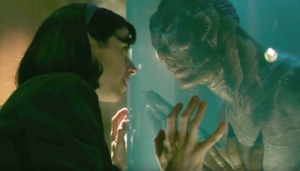The Shape of Water
Posted on December 7, 2017 at 3:37 pm
A-| Lowest Recommended Age: | Mature High Schooler |
| MPAA Rating: | Rated R for sexual content, graphic nudity, violence and language |
| Profanity: | Strong language |
| Alcohol/ Drugs: | Alcohol, smoking |
| Violence/ Scariness: | Intense and graphic violence, peril, torture, murder |
| Diversity Issues: | A theme of the movie |
| Date Released to Theaters: | December 9, 2017 |
| Date Released to DVD: | March 12, 2018 |

There is some reassuring symmetry in the cinematic bookends that gave us “Beauty and the Beast” in January (the highest-grossing film of the year), a “Beauty is the beast” film with the mid-year’s “Colossal,” and now, in December, another variation with Guillermo del Toro’s enthralling R-rated fairy tale, “The Shape of Water,” which was awarded the 2018 Oscars for Best Picture and Best Director.
Sally Hawkins is luminous as Elisa Esposito, a custodian in a secret government lab during the cold war era. Her closest friends are her chatty, unhappily married colleague Zelda (Octavia Spencer) and her neighbor Giles (Richard Jenkins), an anxious, cat-loving, old-movie-watching, out-of-work illustrator. They are the only two people who can communicate with Elisa. She can hear but is mute due to a childhood injury, and uses via American Sign Language.
The film is as gorgeous as any enchanted tale could wish, with a green-blue color palette that evokes the sea and old-school, analog equipment in cavernous rooms and huge, clanking equipment harking back to early horror classics like “Frankenstein” and “Creature from the Black Lagoon” (the later of which del Toro acknowledges as inspiration), with a nod to princess in the castle stories as well.
Elisa discovers one of the lab’s biggest secrets. Strickland (Michael Shannon) a harsh, brutal, “collector,” has captured and brought back to the lab a creature he discovered in the Amazon, a gilled, scaley human-shaped reptilian (played by del Toro regular Doug Jones) who has two separate breathing systems, one for air, one for water. He has some other unusual qualities, which Strickland is not learning much about because he mostly zaps the creature with a cattle prod to “tame” him. Elisa shares her hard-boiled eggs with the creature, and then some music, and then some words, as he begins to learn her language. As we will see, there are parallels between them that make them seem almost like star-crossed lovers kept apart only because they are of different species. Elisa is an orphan who was found not on a doorstep but in the water. The scars on her throat from the abuse that cost her her voice look like gills. Most important, she believes the creature is the only one who sees her as whole, complete, not missing anything.
There is a scientist at the lab named Hoffstetler (Michael Stuhlbarg), who has a secret of his own. There are other people who want to steal the creature and people who just want to kill him because it is more important to keep him away from the enemy than to learn more about who he is and what he can tell us about who we are. Of course, the way we treat him tells us a lot about who we are.
The story capaciously encompases a fairy tale romance with spies, the Cold War, the Civil Rights movement, a heist, and a musical number without, well, losing a step, thanks to del Toro’s ability to create cinematic magic. Hawkins is, as she was in “Maudie” earlier this year, exquisitely able to create a character of fierce intelligence and the kind of gentleness that is grounded in moral courage. Instead of subtitles in white at the bottom of the screen, her words are depicted in yellow letters floating around her, her face communicating as clearly as her hands. The movie is bracketed with images of Elisa floating. By the end, the audience will feel we are floating as well.
Parents should know that this movie includes some elements of horror with graphic and disturbing images, peril, and violence, including torture, sexual references and situations, strong language, smoking and drinking.
Family discussion: How are Elisa and the creature alike? How are Hoffstetler and Strickland different? Why does Giles change his mind?
If you like this, try: “Colossal” and “Pan’s Labyrinth”
